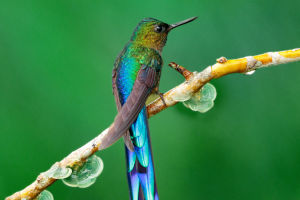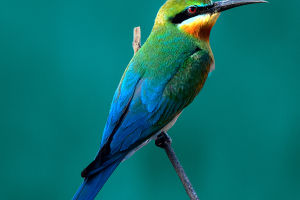The Chestnut-headed Bee-eater is a common bird found in tropical and subtropical regions. These birds have chestnut-brown heads with unique stripes on their chests that are shaped like patterns. Hence, they are named Chestnut-headed Bee-eaters.
These birds are mainly distributed in India, Sri Lanka, Myanmar, Thailand, Central South Peninsula, Malaysia, and Indonesia.
There are some differences between male and female Chestnut-headed Bee-eaters. The male's body is about 205 to 222 cm long and weighs about 25 grams. On the other hand, the female's body is about 210 cm long and weighs about 25 to 26 grams.
Chestnut-headed Bee-eaters come in many colors, but they generally appear in green. The top and upper back of their head is brown maroon, and the wings and tail parts are on the lower half of their back, wings on both sides, and the tail are green.
These birds inhabit open places such as forest margins and rare tree slopes. During winter, Chestnut-headed Bee-eaters sometimes appear in plain jungles, shrub forests, and even reed swamps.
They love to knot groups, and the group consists of more than ten individuals to nearly 100 individuals. They are not mixed with other birds and live alone in groups. Large groups sometimes consist of hundreds of individuals. When Chestnut-headed Bee-eaters are lively and active, they make noise, and their voice can be spread far.
The breeding period of Chestnut-headed Bee-eaters is from April to June. They usually nest in the forest and breed in pairs. Chestnut-headed Bee-eaters lay five to six eggs at a time, which are incubated by male and female birds alternately.
Chestnut-headed Bee-eaters are very independent and self-sufficient birds. They can survive in the wild for a long time without human intervention. However, due to human lifestyle and environmental damage, the living environment of Chestnut-headed Bee-eaters is facing many threats.
Factors such as forest cutting, urban expansion, agricultural activities, and climate change have seriously impacted the living environment of Chestnut-headed Bee-eaters.
To protect Chestnut-headed Bee-eaters and their living environment, we can take a series of measures. Firstly, we should minimize damage to the natural environment as much as possible and protect wild animals and plants and their habitats.
Secondly, we can carry out tree-planting and ecological protection activities in urban and rural areas to provide more living space and food sources for Chestnut-headed Bee-eaters.
In addition, we can understand the ecological characteristics and living conditions of Chestnut-headed Bee-eaters through scientific research. This can provide more targeted measures for their protection and management.
For example, we can further optimize the protection strategies by tracking and monitoring the number and distribution of Chestnut-headed Bee-eaters to understand their ecological environment and habitat requirements.
Chestnut-headed Bee-eaters are essential birds for the ecosystem. They play a vital role in pollination, which helps in maintaining the biodiversity of flora and fauna.
Therefore, it is crucial to take measures to protect these birds and their living environment. By doing so, we can ensure that the ecosystem remains balanced and sustainable for future generations.


